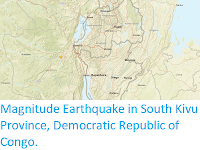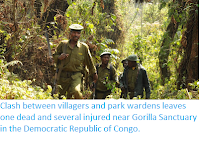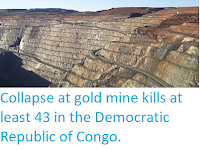Twenty seven people are now known to have died following a collapse at an unlicensed gold min in Haut-Uele Province of the Democratic Republic of Congo on Saturday 14 December 2019. The incident happened at about 5.30 pm local time at Ndiyo, roughly 40 km from the town of Watsa. The miners are understood to have tunnelled about 20 m underground at the site, and rescuers initially thought that the collapse was caused by this activity, but it is now thought to have been the result of a landslide covering the mine, which was itself triggered by days of heavy rain in the area. Landslides are a common problem after severe weather events, as excess
pore water pressure can overcome cohesion in soil and sediments,
allowing them to flow like liquids. Approximately 90% of all landslides
are caused by heavy rainfall.
Landslip above a gold mine at Ndiyo in Haut-Uele Province, Democratic Republic of Congo. Post Online.
The incidents occurred after about a month of heavy rains, in one of the
area's two annual rainy seasons. This two rainy seasons per year pattern
is typical in equatorial
countries, with rainy seasons around the equinoxes and dry seasons
around the solstices. Upland areas of East Africa have always been prone
to
landslides, but the problem has become worse in recent years as a rising
population has led to more agriculture on hill-slopes, in many areas
replacing open woodland where tree roots served to stabilise slopes, and
also to more people living in harms ways. This years rains have been
exceptionally heavy, and fatalities due to similar events have also been
reported in other parts
of Kenya, Somalia, Ethiopian, South Sudan, Sudan, Tanzania, Uganda, the Republic of Congo, Burundi and the Central
African Republic.
The rains this year are thought to have been made worse by the
development of a meteorological phenomenon called a Negative Indian
Ocean Dipole. Indian Ocean Dipole Phases are similar to the El Niño/La Niña
climatic oscillation that affect the Pacific Ocean. Under normal
circumstances equatorial waters off the east coast of Africa and west
coast of Indonesia are roughly similar in temperature, however during a
Negative Indian Ocean Dipole Phase the waters off the coast of Indonesia
become significantly warmer. As the prevailing currents in the area
flow west to east, this warm water is then pushed onto the shallower
continental shelf of north Australia, where it warms the air over the
sea more rapidly, leading to increased evaporation (which fuels rain)
and a drop in air pressure over the east Indian Ocean and west Pacific.
This in turn drives air currents over the Indian Ocean to flow more
strongly west to east, leading to higher rates of cooling off the coast
of Africa (where more water is drawn up from the cool sea depths) and
more warming off the coast of Indonesia, fuelling a feedback cycle that
tends to remain through the winter season in any year when it forms.
This leads to a particularly wet winter across much of Australia, as
well as a potentially damaging heatwave in the north, while much of East
Africa is at risk of drought (during a Positive Indian Ocean Dipole
Phase the reverse happens, with drought in Australia and flooding in
East Africa).
Areas of warming and cooling and air flow during a Negative Indian Ocean Dipole Phase. Australian Bureau of Meteorology.
The Democratic Republic of Congo one of the world's largest producer
of precious metals, but benefits little from
the industry. The country has suffered years of political instability
and has extremely poor infrastructure, is heavily indebted and has a
chronic corruption problem, which means that little of the wealth
generated from the industry makes it into government coffers, and that
which does is unlikely to be spent on development or other projects
likely to benefit the population. These problems are made worse by a
series of conflicts in the area, which plays host to rebel groups
opposed to the Congolese government and militiamen that fled the 1994
conflict in Rwanda and have never returned. In addition the area has
suffered incursions from several neighbouring countries, mostly with an
official purpose of defending borders against Congo's instability, but
with a strong interest in the mining industry. Militia groups linked to
neighbouring states also operate in the area, and again are said to be
involved in illegal mining.
The lack of government control of the area, and low regard for human
life held by many of the groups operating in the area, means that safety
precautions at mines in the area are almost non-existent, with many
mines simply being large holes dug into poorly consolidated sediments.
The area suffers extremely high levels of rainfall (it is the source
from which the Congo, Nile and Zambesi rivers originate), and mines can
rapidly turn into death-traps as their sides turn to mud and collapse
upon the miners.
See also...
Follow Sciency Thoughts on Facebook.








